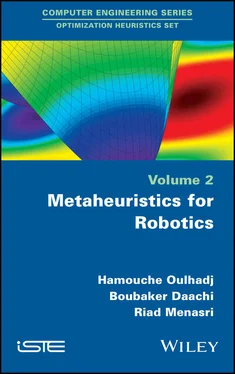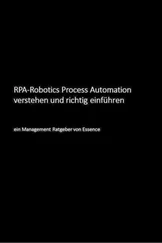1 Cover
2 Preface
3 Introduction
4 1 Optimization: Theoretical Foundations and Methods
1.1. The formalization of an optimization problem 1.2. Constrained optimization methods
1.3. Classification of optimization methods
1.4. Conclusion
1.5. Bibliography
5 2 Metaheuristics for Robotics
2.1. Introduction 2.2. Metaheuristics for trajectory planning problems
2.3. Metaheuristics for automatic control problems
2.4. Conclusion
2.5. Bibliography
6 3 Metaheuristics for Constrained and Unconstrained Trajectory Planning
3.1. Introduction 3.2. Obstacle avoidance
3.3. Bilevel optimization problem
3.4. Formulation of the trajectory planning problem
3.5. Resolution with a bigenetic algorithm
3.6. Simulation with the model of the Neuromate robot
3.7. Conclusion
3.8. Bibliography
7 4 Metaheuristics for Trajectory Generation by Polynomial Interpolation
4.1. Introduction 4.2. Description of the problem addressed
4.3. Formalization
4.4. Resolution
4.5. Simulation results
4.6. Conclusion
4.7. Bibliography
8 5 Particle Swarm Optimization for Exoskeleton Control
5.1. Introduction 5.2. The system and the problem under consideration
5.3. Proposed control algorithm
5.4. Experimental results
5.5. Conclusion
5.6. Bibliography
9 Conclusion
10 Index
11 End User License Agreement
1 Chapter 2Table 2.1. Effects of the actions of the PID regulator
2 Chapter 3Table 3.1. Limits of the robot jointsTable 3.2. Geometric parametersTable 3.3. Position of obstacles in the robot workspaceTable 3.4. Algorithm parameters
3 Chapter 4Table 4.1. Algorithm parametersTable 4.2. Maximum values for the variables of the objective functionTable 4.3. Values of weighting parameters under testTable 4.4. Characteristics of some interpolation methods
4 Chapter 5Table 5.1. Characteristics of the participantsTable 5.2. Controller parameter values
1 Chapter 1Figure 1.1. Domain of admissible solutions and forbidden domainFigure 1.2. 1D multimodal objective function, in the absence of noise Figure 1.3. 1D multimodal objective function, in the presence of noise
Figure 1.4. 2D multimodal objective function, in the absence of noise
Figure 1.5. 2D multimodal objective function, in the presence of noiseFigure 1.6. Constrained optimization. ■ Local minima. • Global minimum. For a co...Figure 1.7. Constrained optimization. ■ Global minimum in the presence of constr...Figure 1.8. Refinement of the performance of an algorithmFigure 1.9. Some deterministic methodsFigure 1.10. Some stochastic methods
2 Chapter 2Figure 2.1. Different stages of trajectory planningFigure 2.2. Hybrid planning: joint space -> Cartesian spaceFigure 2.3. An example of a hybrid planning strategyFigure 2.4. Hybrid planning: Cartesian space -> joint spaceFigure 2.5. Principle of a particle swarm algorithmFigure 2.6. Principle of an evolutionary algorithmFigure 2.7. Trajectory outlineFigure 2.8. Typical system response
3 Chapter 3Figure 3.1. Obstacle modeling. For a color version of this figure, see www.iste....Figure 3.2. Plane used to measure distances. For a color version of this figure,...Figure 3.3. Planar robot with an obstacleFigure 3.4. Illustrated example of obstacle detectionFigure 3.5. Description of the bigenetic algorithmFigure 3.6. Neuromate robot. The Neuromate robot has five degrees of freedom. Al...Figure 3.7. Geometric configuration of the robot. For a color version of this fi...Figure 3.8. Chromosomes of the algorithmFigure 3.9. Evolution of the best individual in the first levelFigure 3.10. Evolution of the best individual at the second levelFigure 3.11. End-effector position errorFigure 3.12. CPU timeFigure 3.13. Successive robot configurations. For a color version of this figure...Figure 3.14. Two solutions found by the algorithm. For a color version of this f...Figure 3.15. Variation in joint variables. For a color version of this figure, s...Figure 3.16. Best individual evolution. For a color version of this figure, see ...
4 Chapter 4Figure 4.1. Example of a polynomial curveFigure 4.2. Algorithm overall outlineFigure 4.3. Solution codingFigure 4.4. Angular positionFigure 4.5. Angular velocityFigure 4.6. Angular accelerationFigure 4.7. Mean and standard deviation of the objective functionFigure 4.8. Maximum velocitiesFigure 4.9. Maximum and minimum accelerationsFigure 4.10. Maximum jerkFigure 4.11. Maximum motion timeFigure 4.12. CPU timeFigure 4.13. Mean and standard deviation of the objective function after converg...Figure 4.14. Maximum velocityFigure 4.15. Maximum accelerationFigure 4.16. Maximum jerkFigure 4.17. Maximum timeFigure 4.18. Angular position with cubic splinesFigure 4.19. Angular velocity with cubic splinesFigure 4.20. Angular acceleration with cubic splinesFigure 4.21. Angular position for five nodesFigure 4.22. Angular velocity for five nodesFigure 4.23. Angular acceleration for five nodes
5 Chapter 5Figure 5.1. Lower limb exoskeletonFigure 5.2. Proposed controllerOrganigram 1. Standard PSO controlOrganigram 2. The proposed modified PSO-based controlFigure 5.3. Experimental environment [DAA 15, MAD 14]Figure 5.4. The mechanical structure of the EICoSI [MAD 14, DAA 15, RIF 12]Figure 5.5. Position trajectory tracking for individual 1. For a color version o...Figure 5.6. Position trajectory tracking for individual 2. For a color version o...Figure 5.7. Position trajectory tracking for individual 3. For a color version o...Figure 5.8. RMS of position trajectory tracking errors. For a color version of t...Figure 5.9. Control inputs for the three individuals 1, 2 and 3. For a color ver...Figure 5.10. Evolution of the adaptive PID parameters. For a color version of th...
1 Cover
2 Table of Contents
3 Begin Reading
1 v Table of Contents 1 Cover 2 Preface 3 Introduction 4 1 Optimization: Theoretical Foundations and Methods 1.1. The formalization of an optimization problem 1.2. Constrained optimization methods 1.3. Classification of optimization methods 1.4. Conclusion 1.5. Bibliography 5 2 Metaheuristics for Robotics 2.1. Introduction 2.2. Metaheuristics for trajectory planning problems 2.3. Metaheuristics for automatic control problems 2.4. Conclusion 2.5. Bibliography 6 3 Metaheuristics for Constrained and Unconstrained Trajectory Planning 3.1. Introduction 3.2. Obstacle avoidance 3.3. Bilevel optimization problem 3.4. Formulation of the trajectory planning problem 3.5. Resolution with a bigenetic algorithm 3.6. Simulation with the model of the Neuromate robot 3.7. Conclusion 3.8. Bibliography 7 4 Metaheuristics for Trajectory Generation by Polynomial Interpolation 4.1. Introduction 4.2. Description of the problem addressed 4.3. Formalization 4.4. Resolution 4.5. Simulation results 4.6. Conclusion 4.7. Bibliography 8 5 Particle Swarm Optimization for Exoskeleton Control 5.1. Introduction 5.2. The system and the problem under consideration 5.3. Proposed control algorithm 5.4. Experimental results 5.5. Conclusion 5.6. Bibliography 9 Conclusion 10 Index 11 End User License Agreement
2 iii
3 iv First published 2020 in Great Britain and the United States by ISTE Ltd and John Wiley & Sons, Inc. Apart from any fair dealing for the purposes of research or private study, or criticism or review, as permitted under the Copyright, Designs and Patents Act 1988, this publication may only be reproduced, stored or transmitted, in any form or by any means, with the prior permission in writing of the publishers, or in the case of reprographic reproduction in accordance with the terms and licenses issued by the CLA. Enquiries concerning reproduction outside these terms should be sent to the publishers at the undermentioned address: ISTE Ltd 27-37 St George’s Road London SW19 4EU UK www.iste.co.uk John Wiley & Sons, Inc. 111 River Street Hoboken, NJ 07030 USA www.wiley.com © ISTE Ltd 2020 The rights of Hamouche Oulhadj, Boubaker Daachi and Riad Menasri to be identified as the authors of this work have been asserted by them in accordance with the Copyright, Designs and Patents Act 1988. Library of Congress Control Number: 2019952981 British Library Cataloguing-in-Publication Data A CIP record for this book is available from the British Library ISBN 978-1-78630-380-6
Читать дальше











